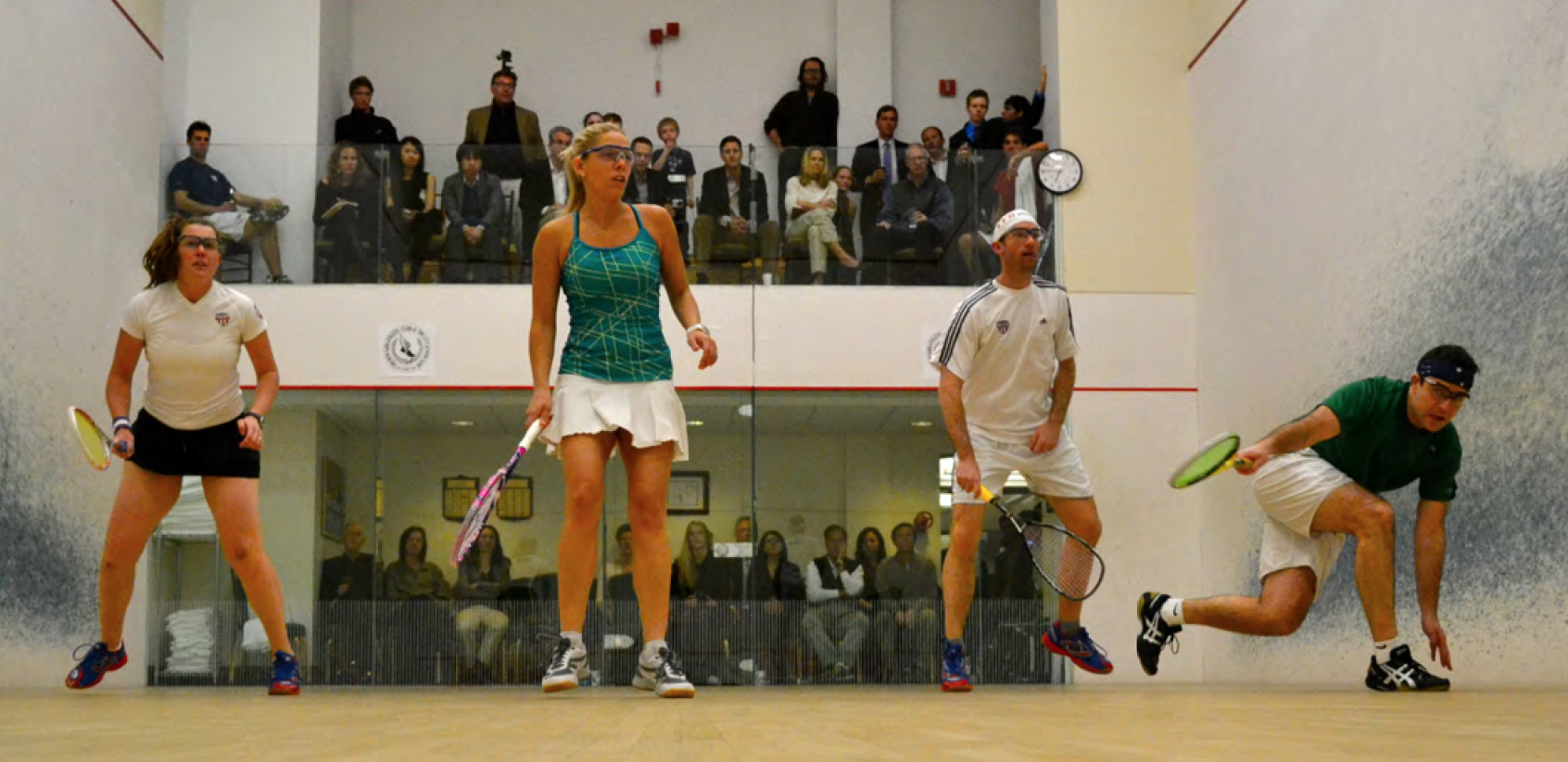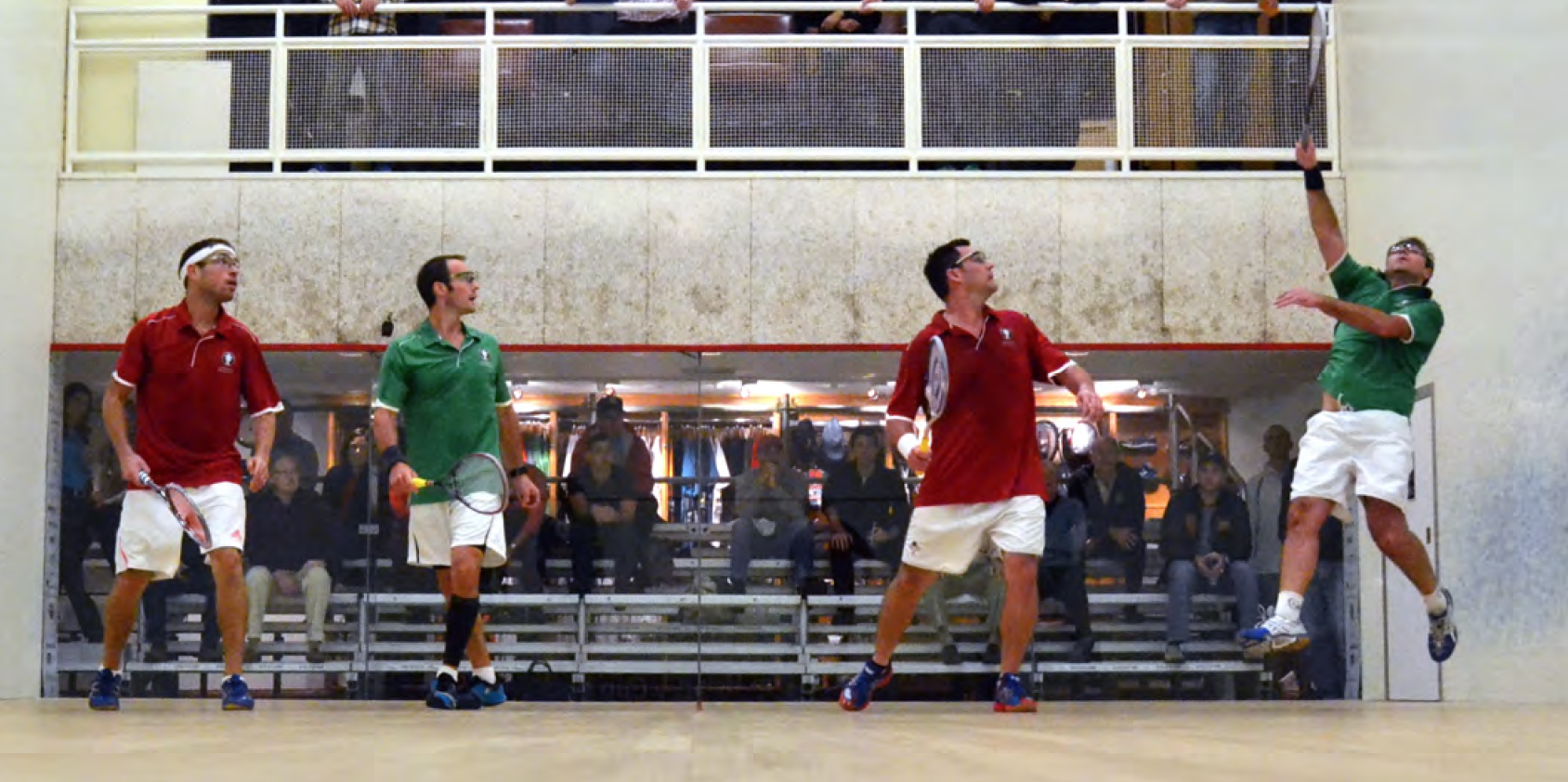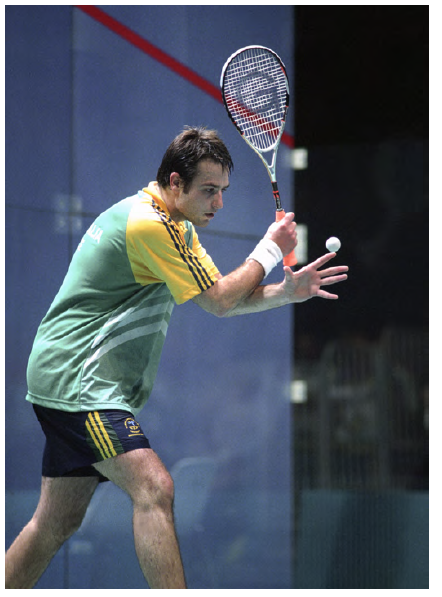By Chris McClintick
Photos by SDA

Squash was the last thing on Paul Price’s mind the week after a five-game loss to Mudge & Gould in the final of the 2014 Putnam Pro-Am. He was more concerned with last-minute wedding details, for which he and his Canadian fiancée, Kyla, would soon be flying to Mexico. Such has been the progression away from squash in Paul’s nearly twenty-year career. A talented musician since his first injury layoff early in his singles career, Price is presented with the choice of holding a guitar or squash racquet.
“I think at this stage of my life it would be more a guitar, with most of my life having held a squash racquet. I’ve thoroughly enjoyed it and it’s been an amazing journey. But as you progress in life, your passions change and, at this point, it would be more guitar and success with business ventures.”
One month ago, Price and partner Clive Leach were on top of the squash doubles world.
The stage was set as the top four doubles players in the world entered the Apawamis Club’s show court to vie for the largest prize money purse on the Squash Doubles Association calendar and the first professional doubles tournament to be streamed live online by SquashTV. The belligerents included joint world No. 1’s Damien Mudge & Ben Gould pitted against world No. 4 and 3 Paul Price & Clive Leach.
The match began with three-time Briggs Cup champion Mudge & Gould—2007 champion with Price—storming ahead 15-12 with their trademark power-hitting style, taking advantage of a fresh hardball’s pace and supported by their innate athletic ability to cover all areas of the court.
Despite the best efforts of Price & Leach to absorb their hard-hitting opponent’s and reply with their precise shot-making, the onslaught continued into the second game culminating in Gould’s trademark forehand separating the sides with a run of late winners to win the second 15-10.
The third game saw the 2013 World Doubles champions uncharacteristically commit a number of unforced errors. Price & Leach capitalized on the mistakes and, at 13-7 up, Price first pulled out a quick-reflex backhand nick, followed by a deceptive drop shot the next point to pull back a game.

Price & Leach successfully continued their strategy of absorbing and manipulating their opponents from front court to back. Leach’s lobs pushed Mudge back just enough to create openings at center court for Price to step in and execute his lethal shot-making. That is until, at 12-9 up, the referee called for a ball switch. A new, lively ball meant an open invitation for Mudge & Gould to put as much pace in their shots as possible. The Australian duo directed their attack towards Leach’s feet, avoiding Price’s adroit racquet control. Despite Leach’s best efforts to keep the fresh ball alive, Mudge & Gould strung together five points until they were one point away from their first Briggs Cup as teammates at 14-12.
With three match balls looming, Price & Leach convened in the back left corner to re-strategize. As play resumed, the Australian/English duo directed their shots above and behind their opponents until Leach caught them off guard in the back of the court with a deft drop shot. A similar sequence of shots led to another straight drop from Leach, forcing a Gould racquet error off the side wall to level the score at 14-14. As Price & Leach continued to control the shot exchange, a lob above Mudge led to a volley into the tin, a fifth game and new life for Price & Leach.
The fifth game started fortuitously for Price & Leach as Leach managed to miss-hit a winner on the first point, which Price followed up with a winning drop shot nick. As the game progressed, Leach continued to move the ball towards the back of the court whenever possible, encouraging Price to step into the pockets of space and employ his inimitable repertoire of shots.
Piling on the pressure up 4-2, Leach & Price found themselves on top of each other in the back right corner. With Leach’s desperate cry of “Pricey!” Price hit a drop shot winner from the back court. At 7-4 up, Price masterfully shot a feigned inside-out reverse nick to create a four point gap. Mudge & Gould attempted to inject more pace into the match, but Price & Leach maintained the gap. Price continued his tear, appropriately with a winning, Aussie triple boast to reach 10-6.
With the onset of cramps and fatigue as the match closed in on the two and a half hour mark, frustrations rose with contentious stoke, lets, and no calls in the match’s final points.
Despite the cramps, Leach dug out a crucial winning backhand triple boast to reach match ball at 14-11. Price tinned the following point, which led to two lets as both sides avoided making vital mistakes. Four strokes into the point, Leach shot a routine crosscourt toward Mudge who back-handed the hardball into the tin.
Mustering their last ounces of energy, Price & Leach screamed with joy before embracing. Both players would later describe this match and moment as the best feeling of their doubles careers.
As the online stream neared the two hour and fifty minute mark, Price stood center court, both hands firmly grasping the coveted Briggs Cup. After acknowledging the pro-am players, his partner Leach and Mudge & Gould, Price announced that the 2013 Briggs Cup was his last.
 “Clive was unbelievable tonight. He does move alright for forty one,” said Price, thirty-seven, to the amusement of the crowd. “Thanks to Peter Briggs for everything you’ve done. The $100,000 prize purse is amazing to play for and we hope that’s the future of doubles moving forward. He puts on an amazing event, the fundraising and everything he does supporting CitySquash and all of you getting onboard his vision.
“Clive was unbelievable tonight. He does move alright for forty one,” said Price, thirty-seven, to the amusement of the crowd. “Thanks to Peter Briggs for everything you’ve done. The $100,000 prize purse is amazing to play for and we hope that’s the future of doubles moving forward. He puts on an amazing event, the fundraising and everything he does supporting CitySquash and all of you getting onboard his vision.
“I think this will be my last Briggs Cup, unfortunately, so it’s nice to win it one more time before moving back to Australia next year. Thank you so much for all the support over the years. I’ve been playing here since my singles days when I was twenty-one. I think I’ve come here every year since, and it’s always welcoming, so thank you for your friendship and hospitality over the years.”
After nearly twenty years in professional singles and doubles squash, Price’s tenure nears its end.
An incessant ruptured disc in his lower lumbar and the cross-pollination of singles and doubles players at the Jim Bentley Memorial Invitational Cambridge Cup brought forth Paul Price’s doubles career.
In 2000, the Cambridge Club of Toronto instituted a change in format for the invitational tournament, deciding to have each of the six teams vie for a $25,000 prize purse that was comprised of the top doubles players being paired with the top singles softball players.
The invitational’s first round conveniently occurred on the same day as the $50,000 YMG Canadian Classic final, meaning the top singles players were more than willing to try their hand in the Cambridge Club’s lucrative event. In November of 2001—the tournament’s second year employing the new format—PSA entrants included world No. 1 David Palmer, world No. 2 Jonathon Power, world No. 4 Martin Heath, world No. 8 Mark Chaloner, wild card Graham Ryding and twenty-five-year-old Paul Price who had reached his highest career world ranking of four in August and September of that year.
Fourteen months prior to his maiden doubles tournament, the Toronto-based Melbourne native was on the road to recovery in Australia from a ruptured disc in his lower back that kept him out of the game for seven months. Having re-aggravated the injury during his first tournament back during September’s Australian Open, which he still managed to reach the finals of, Price began hitting lightly on court again two weeks ahead of the 2000 British Open. Having found a back specialist who had him running on court again, Price felt he should try to play the British Open, at the very least to accumulate some much-needed rankings points after his lengthy absence. Seeded fourteenth in Birmingham, Price reached the finals, losing to David Evans in three games.
In 2001, Price remained healthy enough to compete in twelve events leading up to November’s Bentley Cup, including a semifinal finish in the Tournament of Champions, and reaching the final of the $60,000 Flanders Open in which he defeated fellow Aussie David Palmer in the semifinals. In October, Price played second spot behind Palmer in the Australian Men’s World Team Championship-winning side.
Price was fresh with two days rest ahead of the Bentley having exited the Canadian Classic in the quarterfinals to Power. His partner was twenty-five-year-old countryman Damien Mudge, who seven years earlier played alongside Price in the World Junior Team Championships and had just completed his first of what would be three undefeated seasons with partner Gary Waite.
Mudge & Price, with Price on the right wall finished fourth, but more importantly Price discovered that doubles was easier on his back. Mudge & Price returned to the Bentley in 2002—traditionally held Thanksgiving weekend but moved ahead to accommodate the PSA players that year—but could not better their debut appearance that time, falling outside of the top four. Following one of his most successful seasons with three PSA titles and a second World Team Championship with Australia, Price returned to the Cambridge Club in 2003, this time with Canadian Mike Pirnak—narrowly losing in five games to eventual champions Waite & Heath, then winning the third place match against Chaloner & Blair Horler.
2004 proved to be Price’s final full season on the PSA tour before his back forced him to retire, although Price managed to end the year with a quarterfinal berth as a qualifier in the Canadian Classic and first round upset against a young Karim Darwish. Following his retirement from singles that month, Mudge & Price reunited and won the Bentley.
Price began to play doubles more often in the doubles-hotbed that is Toronto as he served as a professional at the Toronto Racquet Club from 2004 to now. Mudge & Price again won the Bentley in 2005, then in 2006, Price received a call from doubles stalwart Jamie Bentley ahead of his final season. Bentley convinced Price to pair with him for Price’s first full season on the doubles tour.
“Paul picked up the game very quickly,” recalls Bentley. “He is obviously a huge talent and just needed to be told where to stand and some basic strategy. We hit a lot on our own at the beginning and then started playing matches. He wanted to learn, and he asked a lot of questions. I kept feeding him the gospel and he enjoyed the little nuances of the game.”
Price & Bentley would go on to win Bentley’s father’s namesake tournament in 2006 and Bentley’s last professional win before his retirement due to injury. Down 2-1 in the final at Bentley’s home club, Price & Bentley went on to win 15-12, 15-4 as Price hit eighteen winners.

“I’ve watched, refereed, and judged doubles for roughly thirty-five years, played with and watched numerous great players. On their best day, in my opinion Paul would be the best ever, the amount of different shots he can hit both sides is incredible. He can plain and simply end points.”
The season following Bentley’s retirement, Price received a call from Ben Gould to be his left-waller. Price & Gould’s partnership immediately catapulted to the heights of the doubles tour. Price & Gould stole the world No. 1 tag, defeating Mudge & Waite five out of six of their meetings. That season, Price also notched a 2007 U.S. Mixed Doubles championship with Narelle Krizek, a childhood friend from their time together at the Australian Institute of Sport. Price & Krizek reunited in 2013 to win the World Mixed Doubles Championships for Australia.
“Paul has been inspiring at both singles and doubles,” Krizek said. “He is one of the most talented players I have ever watched. He has the best hands of any doubles player and is amazing to watch as he comes up with unbelievable, inspiring shots. I wish him all the best in Australia. He will definitely be missed in the U.S. and Canada, but I’m fortunate to have him as a friend and know many others will miss him dearly too.”
Between the years 2007-2010, Price & Gould won twenty-two tournaments, including the 2007 Briggs Cup, the 2007 and 2009 North American Opens, the 2009 World Doubles, the 2010 Kellner Cup, and two more Bentley Cups in 2007 and 2008.
Towards the end of the 2009-2010 season, Price’s back worsened causing him to miss the following season entirely. During the 2011-2012, Price returned to play a few tournaments with James Hewitt, but questioned whether or not he would continue playing. Then Clive Leach called.
In their first full season as partners, Price & Leach were the sole team to challenge the hegemony of Mudge & Gould, having defeated the 2013 World Doubles champions in the 2013 Putnam Pro-Am and the North American Open until once again, Paul’s back ended his season prematurely.
“Pricey has a beautiful compact swing where he adjusted quickly to knowing where his body needed to be and the initial pace coming at you,” Leach said. “The thing with Paul is that you’ve got to let him play. You have a strategy in place, then the next thing you know he could be doing the exact opposite of what you just said because he puts balls in places where it’s irretrievable. It’s crazy really what he comes out with, his side-fronts, from the back, his middle angles, he has so many options on the court. On court, he’s the best player out there in terms of his all-around play. I don’t think he gets that recognition.
“Not enough guys have the belief, two hours on court and can strategize and take on Damien and Ben. With Paul, I can adjust, we can tweak our strategies and apply it. It’s one thing to set up strategies, but can you actually apply it? With Paul you can because he can adjust his game in so many different ways. That’s the comfort of playing with him, it’s amazing really.”
With six more events left on the 2013-2014 Squash Doubles Association calendar and the possibility of playing one or two more tournaments in the fall before Paul and Kyla move to the southern hemisphere, Price’s career isn’t over yet—back-permitting.
These remaining tournaments are a final opportunity to witness one of the most versatile, gifted players to reach the heights of both the singles and doubles realms—and one of the best to have played the game. After a seventeen-year journey, Price is going home.





